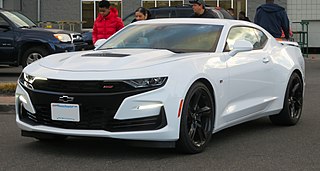
The Chevrolet Camaro is a mid-size American automobile manufactured by Chevrolet, classified as a pony car. It first went on sale on September 29, 1966, for the 1967 model year and was designed to compete with the Ford Mustang. The Camaro shared its platform and major components with the Firebird, produced by General Motors' Pontiac division that was also introduced for 1967.

The Ford Torino is an automobile that was produced by Ford for the North American market between 1968 and 1976. It was a competitor in the intermediate market segment and essentially a twin to the Mercury Montego line.

The Ford Probe is a liftback coupé produced by Ford, introduced in 1988 and produced until 1997. The Probe was the result of Ford's collaboration with its longtime Japanese partner Mazda, and both generations of Probe were derived from the front-wheel drive Mazda G platform that underpinned the Mazda Capella.

The Mercury Cougar is a series of automobiles that was sold by Mercury from 1967 to 2002. The model line is a diverse series of vehicles; though the Cougar nameplate is most commonly associated with two-door coupes, at various stages in its production, the model also was offered as a convertible and a hatchback. During its production as the mid-size Mercury line, the Cougar was also offered as a four-door sedan and five-door station wagon.
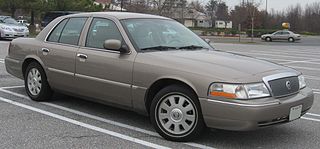
The Mercury Grand Marquis is an automobile that was sold by Mercury from 1975 to 2011. Introduced as the flagship sub-model of the Mercury Marquis, the Grand Marquis became a stand-alone model line for 1983, serving as the largest Mercury sedan. Subsequently, the model line would serve as the sedan counterpart of the Mercury Colony Park station wagon; it would later serve as the basis of the revived Mercury Marauder.

The Nissan 350Z is a two-door, two-seater sports car that was manufactured by Nissan Motor Corporation from 2002 until 2009 and marks the fifth generation of Nissan's Z-car line. The 350Z entered production in 2002 and was sold and marketed as a 2003 model from August 2002. The first year there was only a coupe, as the roadster did not debut until the following year. Initially, the coupe came in Base, Enthusiast, Performance, Touring and Track versions, while the Roadster was limited to Enthusiast and Touring trim levels. The Track trim came with lightweight wheels and Brembo brakes, but its suspension tuning was the same as all other coupes. The Nissan 350Z was succeeded by the 370Z for the 2009 model year.
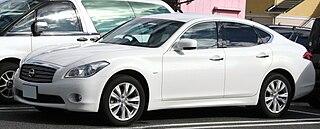
The Nissan Fuga is a mid-size luxury sedan produced by Japanese automaker Nissan since October 2004. It is built on a wider, stretched wheelbase version of the Nissan FM platform. After the Nissan Cima and Nissan President were discontinued in August 2010, the Fuga became Nissan's flagship vehicle. In North America and Europe, the Fuga is sold as the second and third-generation Infiniti M, where it has been the flagship of the Infiniti luxury division of Nissan since 2006.

The Shelby Mustang is a high-performance variant of the Ford Mustang built by Shelby American from 1965 to 1967 and by the Ford Motor Company from 1968 to 1970.

The Gloria is a large luxury car made from 1959 by the Prince Motor Company, and later by Nissan Motors since its merger with the former - hence being originally marketed as Prince Gloria and later as Nissan Gloria. Initially based on the smaller Prince Skyline, the Gloria line was merged with Nissan Cedric starting with 1971 models and both continued until 2004, when they were both replaced by Nissan Fuga.

The Nissan Cedric is a large automobile produced by Nissan since 1960. It was developed to provide upscale transportation, competing with the Prince Skyline and Gloria which were later merged into the Nissan family. In later years, the Nissan Skyline was positioned as a sports sedan/coupe, whereas the Nissan Gloria was turned into a sporty version of the Cedric.

Specialty Equipment Market Association (SEMA) of the automobile aftermarket was formed in 1963 by Paul Schiefer, Roy Richter, Ed Iskenderian, Els Lohn, Willie Garner, Bob Hedman, Robert E. Wyman, John Bartlett, Phil Weiand Jr, Al Segal, Dean Moon, and Vic Edelbrock Jr. and now consists of 6,383 companies worldwide, bringing together aftermarket manufacturers, original equipment manufacturers (OEM), media, car dealers, specialty equipment distributors, installers, retailers, and restoration specialists.
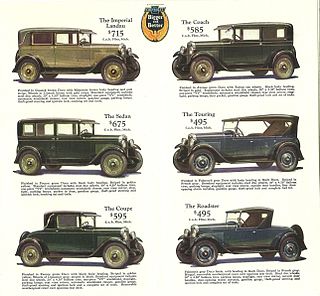
The model of a car is its design, in the context of the manufacturer's range or series of cars. Different models are distinguishable by technology, components, underpinnings, and/or style and appearance.
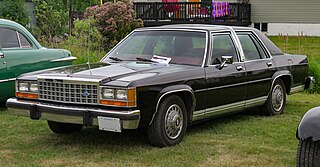
The Ford LTD Crown Victoria is a line of full-size cars that was manufactured and marketed by Ford from the 1980 to 1991 model years. Deriving its name from the Ford Fairlane coupe of 1955–1956, the LTD Crown Victoria served as the flagship of the Ford LTD model range in North America. Serving as the Ford counterpart of the Mercury Grand Marquis, the model line was offered as a two-door and a four-door sedan and a five-door station wagon.
MagneRide is an automotive adaptive suspension with magnetorheological damper system developed by the Delphi Automotive corporation, that uses magnetically controlled dampers, or shock absorbers, for a highly adaptive ride. As opposed to traditional suspension systems, MagneRide has no mechanical valves or even small moving parts that can wear. This system consists of monotube dampers, one on each corner of the vehicle, a sensor set, and an ECU to maintain the system.
Ford Mustang variants are the various versions of the Ford Mustang car, modified either by its manufacturer Ford Motor Company or by third-party companies. Ford and several third-party companies have offered many modified versions of the highly popular Mustang since its creation in 1964 in order to cater to specific portions of the marketplace outside of the mainstream. High-performance enthusiasts seek more powerful, sharper handling, sports cars such as the Shelby Mustang, the Ford Mustang Mach 1, and variants made by Roush Performance and Saleen, while collectors and purists seek limited production and alternate or nostalgic styling, such as is commonly found on many commemorative editions. Still, others were made purely for experimental concepts such as the McLaren M81 and the Ford Mustang SVO, which later influenced production model design. Most variants include both performance upgrades, and unique cosmetic treatments that are typically minimal to maintain the familiar appearance of a stock Mustang. Although most of these Mustang variants were aimed at enthusiasts, an exception was the Special Service Package which was designed specifically for law enforcement. Race variants include the FR500, Boss 302 and Boss 429.

The fourth-generation Ford Mustang is an automobile that was produced by the American automobile manufacturer Ford Motor Company for the 1994 through 2004 model years. Marking the first major redesign of the Ford Mustang in fifteen years, the fourth generation of the pony car was introduced in November 1993 with the launch taking place on December 9, 1993. The design, was based on an updated version of the Fox platform and was the final vehicle underpinned with this platform. It featured styling by Bud Magaldi that incorporated some stylistic elements from the classic Mustangs. A convertible model returned, but the previous notchback and hatchback bodystyles were discontinued in favor of a conventional 2-door coupe design.

The fifth-generation Ford Mustang (S197) is a pony car manufactured and marketed by Ford from 2004 to 2014, for model years 2005 to 2014. Assembly took place at the Flat Rock Assembly Plant in Flat Rock, Michigan. The fifth generation began with the 2005 model year, and received a facelift for the 2010 model year.

A brougham was originally a car body style where the driver sat outside and passengers seated within an enclosed cabin, — deriving the configuration from the earlier brougham horse-drawn carriage. Similar in style to the later town car, the brougham style was used on chauffeur-driven petrol and electric cars.
The FPV GT R-spec is a range of enhanced FPV vehicles characterised by an upgraded handling package fitted to the base model GT, range-topping GT-P and turbocharged F6 Typhoon models. At the time of its production, the GT & GT-P "R-spec" was the quickest Australian production car ever produced.

The sixth-generation Ford Mustang (S550) is a pony car that was manufactured by Ford from 2014 until 2023. In departure from prior Mustang models, the sixth-generation Mustang included fully independent rear suspension on all models, as well as an optional 2.3L EcoBoost turbocharged and direct injected four-cylinder engine. The Mustang was introduced as a 2015 model year vehicle, marking the fiftieth anniversary of the Ford Mustang, which was revealed as a 1965 model year vehicle on April 17, 1964.



















